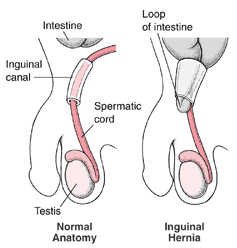An inguinal hernia occurs when soft tissue protrudes through the abdominal muscles. The soft tissue can be part of the intestine or part of the membrane that's around the abdominal cavity (omentum). The bulge can be quite painful, especially when you lift heavy objects, cough, or bend over. It gets worse when standing and feels better when lying down. When left untreated, this may lead to strangulation that refers to a situation in which the bulge blocks the blood supply to part of the bowel.

Inguinal Hernia Anatomy: Direct vs. Indirect
Inguinal hernia can be of two types, indirect or direct. Here is a bit more about both types.
Direct Inguinal Hernia
You have direct inguinal hernia when it enters in the fascia of the abdominal wall. Its sac is usually medial to the inferior epigastric vessels. It can affect both males and females, but men are ten times more susceptible to developing this type of hernia. A direct inguinal hernia will come out of an area in the transversalis fascia within the Hesselback's triangle, which is the anatomic region by the edge of the rectus abdominis muscle. The hernia cannot extend into the scrotum – it comes out via the superficial inguinal ring.
You are more likely to deal with direct hernias when your abdominal walls become weak with age. Some other risk factors include chronic cough, chronic constipation, obesity, family history of direct inguinal hernias, and prior episodes of hernias.
Indirect Inguinal Hernia
An indirect inguinal hernia occurs when the deep inguinal ring fails to close properly after the testicles have passed through it. Quite like other hernias, indirect hernias will also protrude via the shallow inguinal ring and lead to groin hernia. By learning more about inguinal hernia anatomy, you will understand the real cause of indirect inguinal hernias.
A baby boy will have a coat to the testicles as it passes through the inguinal ring, which will make a temporary connection called the processus vaginalis. The processus is obliterated after the testicles have completed descended. The inguinal canal has the deep inguinal ring at its beginning, which allows for enough space for the spermatic cord to pass. When the opening space is larger than what is required for the spermatic cord, this may lead to an indirect inguinal hernia.
How Can It Be Treated?
Your doctor will conduct a physical exam to confirm if you have inguinal hernia. They may also ask you about certain signs and symptoms along with looking for a bulge in your groin area. You may have to cough hard to make your hernia more prominent.
Your doctor will consider how large or small your hernia is. If it is small, your doctor will suggest following a "wait-and-watch" approach. You don't need any treatment for small hernia, but it is important to go for surgery to treat enlarged or painful hernia to prevent serious complications.
If you do need surgery, you will have two options – herniorrhaphy and laparoscopy.
Herniorrhaphy
Also called an open hernia repair, the procedure involves making an incision in your groin to send the protruding intestine or omentum back into its original place in your abdomen. Your doctor will then sew the torn muscle with the weak area being reinforced with a synthetic mesh. You should try to move as soon as you can without feeling any pain. It may take up to four weeks or even more to get back to your normal activities.
Laparoscopy
This is a minimally invasive procedure and involves operating through a very small incision in your abdomen. Your doctor will insert a small tube with an attached camera into the incision to repair the hernia. Since the procedure does not involve large incision, you are more likely to return to your normal activities early. You may consider laparoscopy if your hernias have recurred after traditional hernia surgery. This is important to prevent any car tissue from forming. Your doctor may recommend laparoscopy if you have bilateral inguinal hernias.
Considering the inguinal hernia anatomy, some experts believe that a laparoscopic repair has an increased risk of complications. It is, therefore, important to ask a professional and experienced surgeon to perform the procedure. Don't go for this procedure if you have very large hernia, you have had pelvic surgery in the past, and you cannot receive general anesthesia.
How to Prevent Inguinal Hernia
With knowledge about inguinal hernia anatomy, you can understand what you can do to prevent it from happening in the first place. What you should understand is that you cannot do much about the congenital defect that increases your risk for developing inguinal hernia. Here are some steps you can take to keep things under control.
- You should be active and exercise regularly to maintain a healthy weight. Be sure to talk to your doctor about the exercise you can or cannot do in your condition.
- You should work with a dietician or ask your doctor to help you make a diet plan. Be sure to eat plenty of vegetables, fruits, and whole grains that contain dietary fiber. It is important to prevent straining and constipation to avoid making your hernias worse.
- Avoid heavy lifting as much as possible. If you really need to do some lifting, bend from your knees. Never bend from your waist or you will end up making things worse.
- You need to avoid smoking because it will cause a chronic cough that can aggravate an inguinal hernia.
You need to bear in mind that when you have inguinal hernias, you cannot correct this situation with a supportive garment designed to keep hernias in place. You should wear it though if your doctor has asked you to wear it for a short time before your surgery.
